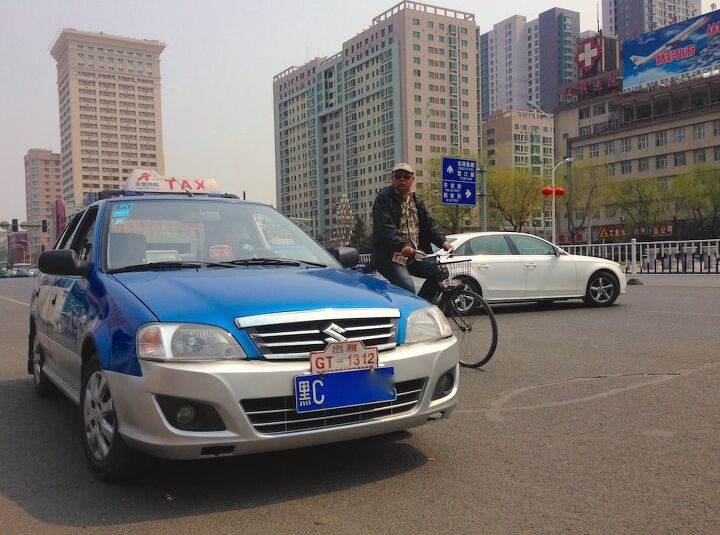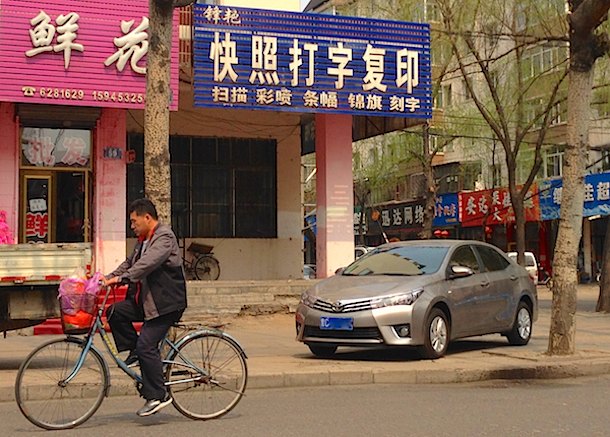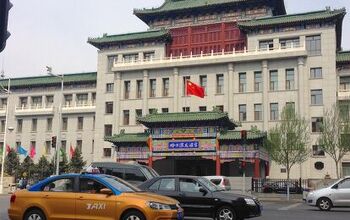China 2015: Cars of Mudanjiang, Heilongjiang Province
After Yanji in the Korean Autonomous Prefecture, we are now headed north to cross over to Mudanjiang in the Heilongjiang province, home to just under 1 million inhabitants.
Mudanjiang does have an airport, but it doesn’t have direct flights to either Yanji or Harbin, so it’s bus riding all the way for me to join these 3 cities and a good opportunity to check out the car landscape in the hilly Chinese countryside.
The Hyundai ix25 is already one of the best-selling models in Mudanjiang.
In actual fact, it’s a pretty bare landscape as there are not many private motorised vehicles in the area, let alone new ones. Of note are a handful of Chery QQ3 sedans, the Suzuki Lingyang, Chery Cowin 2 and the ubiquitous Chana and Hafei minivans. Definitely a huge potential for growth here.
Fun: tri-wheelers seem to be the taxi of choice in Dongjing halfway between Yanji and Mudanjiang (see below).
Tri-wheeler taxis in Dongjing
The Russian influence is logically getting stronger and stronger as we get further north and away from Beijing. Relaxed and modern Mudanjiang reminds me a lot of Moscow in the way the streets are laid out: massive 2 x 4 lanes with large parking spaces on each side, not much vegetation and near-skyscraper housing sprouting up. It could be depressing, but strangely, staying in Mudanjiang ended up being an exhilarating experience. I really felt like I was setting foot where almost no other Westerner had before. I haven’t spotted any since I left Shanghai. Smiles everywhere, an obsession with making sure my seat-belt was buckled up either in the bus or in taxis (unheard of in China), and people in the street watching my every move — stunned, amused and curious, but not wary at all.
Haval H2
The first obvious sight when arriving in Mudanjiang is the cheap taxis, like in many other Chinese cities still coming to grips with private car ownership. And cheap they are: you’d be hard pressed paying more than 10 yuan ($1.60 USD) for any ride around town, whether you’re on your own or you bring your entire family. As a Mudanjiang local, it would surely make you think twice before sinking your hard-earned cash in a new car, even a Chana micro pickup truck worth around 30,000 yuan ($4,700 USD). This is the context in which domestic carmakers evolve in China: competing with taxis that cost nothing. Taxis in Mudanjiang are a unique mix of Suzuki Lingyang (a 1989 Suzuki Swift sedan still on sale in China as pictured atop this report), FAW V5, Kia Rio and Hyundai Elantra in order of popularity.
ZX Auto Grand Tiger and FAW V5 taxi in Mudanjiang
So what do the friendly people of Mudanjiang drive? Here the car landscape is also unique, and once again distinctly different from the one in Yanji or even Changchun. If the Chinese car ratio is roughly the same (1/3) it is achieved mainly by older models. I would expect Chinese carmakers to hold a very small market share in 2015, not more than 15-20 percent. Even though Mudanjiang is roughly twice the size of Yanji, the park is older and includes more microvans (10-15 percent of the traffic) and pickups (8 percent) with a large variety of brands, including the ZX Auto Grand Tiger, becoming a lot more popular, as well as Huanghai, Gonow and old Great Wall Steeds. This seems to indicate the Mudanjiang market is a little less developed/wealthy than Yanji.
Great Wall Steed and VW Jetta
Another observation confirming this status, although it is counter-intuitive, is the much higher proportion of larger, foreign SUVs: Lexus LX, Toyota Prado, Highlander, Honda CR-V, Hyundai Santa Fe and the first Lincoln MKX and Navigator of this trip. On the contrary, domestic SUVs apart from the FAW Besturn X80 and a few ChangAn CS35 are almost absent whereas their foreign counterparts like the Hyundai ix25, Honda Vezel/XR-V (all 3 already frequent), Kia KX3 (the first in this trip) and Buick Encore are being snapped up en masse.
Huanghai and Great Wall pickups
Why is this an indication that Mudanjiang has a less mature car market? In less developed markets, luxury options tend to weigh more as only the wealthiest customers can afford a new car. They then choose a more luxurious option to establish their status than they would at equal wealth in a more developed environment. The less-to-do drivers haven’t bought into the Chinese SUV craze just yet, remaining in a ‘sedan’ mentality for now. It’s only a question of taste because small Chinese SUVs and affordable foreign small and compact sedans are priced similarly as you’ll see below.
Hyundai Verna and Honda Crider
In this context, the new cars that stand out in the Mudanjiang landscape, apart from the Hyundai ix25 that could seriously pretend to an overall Top 10 ranking, are the previous generations of nameplates still on sale in China, namely the Toyota Corolla EX and Hyundai Elantra Yuedong, and foreign affordable models like the Hyundai Verna, Toyota Vios and Nissan Tiida. To give you some perspective, the Hyundai ix25 starts at 119,000 yuan ($18,600 USD) and Buick Encore at 149,900 ($23,400 USD), while the Toyota Vios starts at 69,800 yuan ($10,900 USD), Hyundai Verna at 73,900 ($11,500 USD) and the Corolla EX at 90,800 ($14,200 USD).
Toyota Corolla EX
At these prices, buyers would be able to afford a JAC Refine S3 (65,800 yuan or $10,300 USD), Zotye T600 (79,800 or $12,450 USD) or Haima S5 (89,800 or $14,000 USD) — yet they don’t. The only domestic SUV to be successful to-date in Mudanjiang is the FAW Besturn X80 which starts at 119,800 yuan ($18,700 USD), the same price as a Hyundai ix25 — and a different category of buyers altogether. So to summarise: wealthy buyers buy SUVs, poorer buyers buy sedans. In this aspect, the Mudanjiang market is late compared to where China is nationally (the whole market is upsizing to SUVs), and is closer in purchase patterns to Russia — which makes sense given Russia is less than 60 miles away.
Volkswagen is at its weakest in any Chinese city I have visited so far, and the only explanations I could find for this observation are a less dense dealership network and prices out of reach for most buyers. Saying instead that Mudanjiang car buyers completely disregard Volkswagen to opt for fellow Asian carmakers at similar prices wouldn’t make much sense as it would make this city the only one so far in China to develop this taste. Price does seem to be the issue.
Kia KX3 and Buick Encore
Let’s end on a last surprise: the national best-seller, the Wuling Hongguang, is proving very discreet in Mudanjiang. I only saw a handful of them, and the first Beijing Auto Weiwang M20 of this trip – one of its clones. Once again I will advance the explanation that Mudanjiang may be a few years late adopting national trends. Small shop owners haven’t yet upsized from their microvan to the Hongguang and its equivalents.
The next stop in this exploration of North-Eastern China is the capital of the Heilongjiang province: Harbin. Stay tuned…
Matt Gasnier is based in Sydney, Australia and runs a website dedicated to car sales, trends and analysis called BestSellingCarsBlog.
Mudanjiang street scene
ZX Auto C3 Urban Ark
Hafei Minivan
Hyundai Elantra Yuedong and Suzuki Lingyang taxi
Mudanjiang street scene
Toyota Corolla
Nissan Sylphy
Mudanjiang street scene
Great Wall Haval H6
Liebao SUV
More by Matt Gasnier
Latest Car Reviews
Read moreLatest Product Reviews
Read moreRecent Comments
- Redapple2 I gave up on Honda. My 09 Accord Vs my 03. The 09s- V 6 had a slight shudder when deactivating cylinders. And the 09 did not have the 03 's electro luminescent gages. And the 09 had the most uncomfortable seats. My brother bought his 3rd and last Honda CRV. Brutal seats after 25 minutes. NOW, We are forever Toyota, Lexus, Subaru people now despite HAVING ACCESS TO gm EMPLOYEE DISCOUNT. Despite having access to the gm employee discount. Man, that is a massive statement. Wow that s bad - Under no circumstances will I have that govna crap.
- Redapple2 Front tag obscured. Rear tag - clear and sharp. Huh?
- Redapple2 I can state what NOT to buy. HK. High theft. Insurance. Unrefined NVH. Rapidly degrading interiors. HK? No way !
- Luke42 Serious answer:Now that I DD an EV, buying an EV to replace my wife’s Honda Civic is in the queue. My wife likes her Honda, she likes Apple CarPlay, and she can’t stand Elon Musk - so Tesla starts the competition with two demerit-points and Honda starts the competition with one merit-point.The Honda Prologue looked like a great candidate until Honda announced that the partnership with GM was a one-off thing and that their future EVs would be designed in-house.Now I’m more inclined toward the Blazer EV, the vehicle on which the Prologue is based. The Blazer EV and the Ultium platform won’t be orphaned by GM any time soon. But then I have to convince my wife she would like it better than her Honda Civic, and that’s a heavy lift because she doesn’t have any reason to be dissatisfied with her current car (I take care of all of the ICE-hassles for her).Since my wife’s Honda Civic is holding up well, since she likes the car, and since I take care of most of the drawbacks of drawbacks of ICE ownership for her, there’s no urgency to replace this vehicle.Honestly, if a paid-off Honda Civic is my wife’s automotive hill to die on, that’s a pretty good place to be - even though I personally have to continue dealing the hassles and expenses of ICE ownership on her behalf.My plan is simply to wait-and-see what Honda does next. Maybe they’ll introduce the perfect EV for her one day, and I’ll just go buy it.
- 2ACL I have a soft spot for high-performance, shark-nosed Lancers (I considered the less-potent Ralliart during the period in which I eventually selected my first TL SH-AWD), but it's can be challenging to find a specimen that doesn't exhibit signs of abuse, and while most of the components are sufficiently universal in their function to service without manufacturer support, the SST isn't one of them. The shops that specialize in it are familiar with the failure as described by the seller and thus might be able to fix this one at a substantial savings to replacement. There's only a handful of them in the nation, however. A salvaged unit is another option, but the usual risks are magnified by similar logistical challenges to trying to save the original.I hope this is a case of the seller overvaluing the Evo market rather than still owing or having put the mods on credit. Because the best offer won't be anywhere near the current listing.
























































Comments
Join the conversation
Dude carrying 6 boxes like a boss. This is interesting. I wish I knew more about the chinese car brands, but I just haven't followed them at all. :/
Trying to follow the domestic Chinese auto industry is like trying to follow the American auto industry 90-100 years ago: Way too many marques, most of them regional without the long term hope in hell of surviving on a national basis. Get past a few big ones that have managed to get some degree of international recognition (Geeley, SAIC, FAW, Brilliance) and the mind glazes over. And if you don't believe me, just look up a list of all the American automobile marques in production during the 1920's. How many of them have you ever heard of?